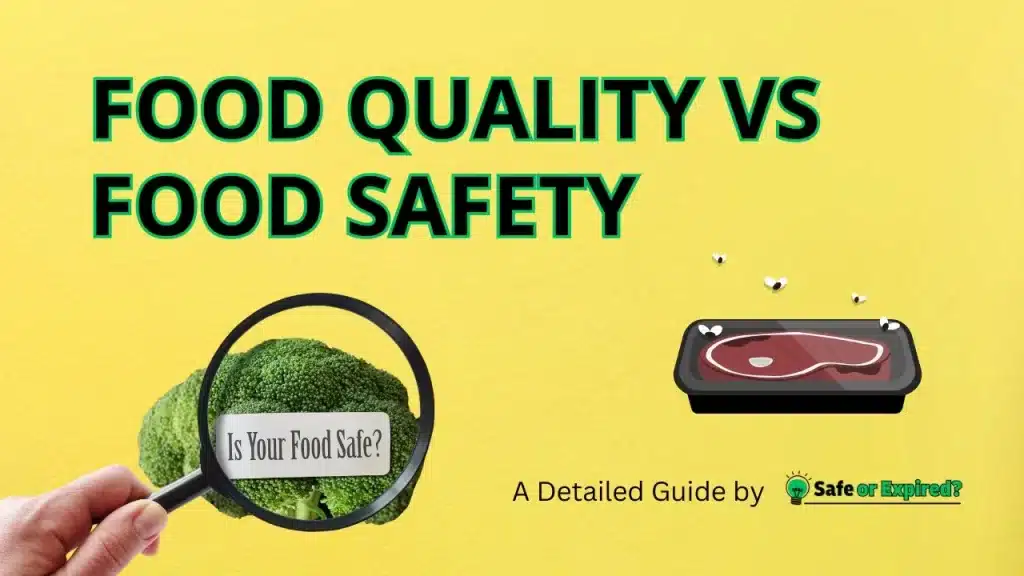People always search for “food quality vs food safety” as there is a fine line between both. While one ensures your food is delicious, the other guarantees it’s safe to eat. In this engaging article, you will learn what makes food both good and safe. In the end, there are also some vital tips to maintain food safety and quality.
Understanding Food Quality
Food quality is all about how awesome food is in terms of taste, texture, appearance, and nutritional value. It’s not just about making sure food won’t make you sick (that’s food safety), but about the whole experience of eating.
These are the key components of food quality.
- Taste: The most obvious part of food quality is how it tastes. Good food should taste exactly how it’s supposed to. Like, an apple should be sweet and a bit sour, not tasteless or bitter.
- Appearance: Food needs to look appetizing. If an apple has lots of bruises, you might not want to eat it, right? Good quality food looks fresh and inviting.
- Nutrition: This is about what’s inside the food that’s good for your body. High-quality food is not just tasty. It also gives your body what it needs (nutrients).
- Safety: Food also needs to be safe to eat. This means it shouldn’t have anything harmful in it, like germs or chemicals.
- Freshness: Fresh food is also a sign of good quality. If something is supposed to be eaten fresh, like fruits or vegetables, it should be sold when it’s just right, not too early or too late.
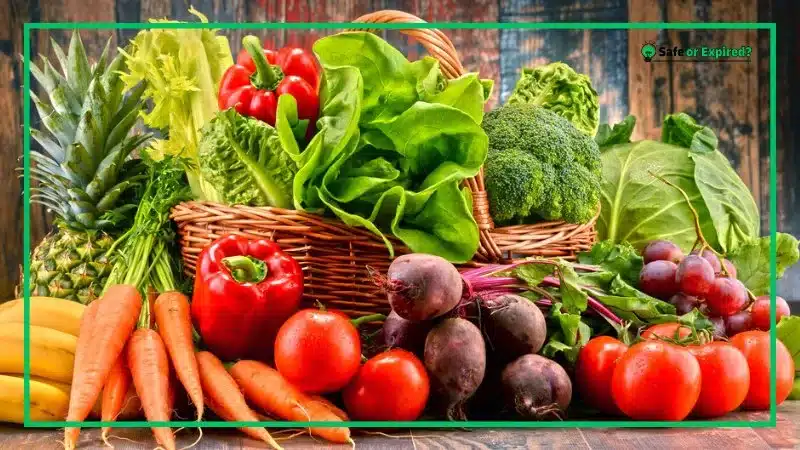
Understanding food quality means looking at all these parts together. It’s like being a detective with your food, checking if it looks right, tastes good, and is good for you. This way, you can enjoy your food knowing it’s the best it can be!
Understanding Food Safety
According to the CDC, Food safety is about handling, storing, and preparing food in a way that prevents contamination and reduces the risk of foodborne illness. WHO says that food safety involves practices and measures that ensure food is safe to eat by avoiding the presence of harmful bacteria, viruses, parasites, and chemicals.
Adhering to guidelines from top food safety institutions is crucial for a better shelf life. For detailed standards and recommendations, check out “Food Safety Guidelines by Top 4 Institutions.“
According to Harvard, food safety is important because.
- It keeps us healthy and safe from foodborne illnesses.
- It helps maintain the nutritional value of food.
- It ensures that food tastes good and is enjoyable to eat.
- It protects the reputation of food businesses.
Note that these are the core principles of food safety.
- Clean: Always start with clean hands, utensils, and surfaces. It’s like the golden rule of cooking. Bacteria love to hitch a ride on dirty hands or cutting boards, so washing up is a big deal.

- Separate: Raw chicken and salad veggies don’t mix. Keeping them separate avoids cross-contamination, where germs from one food get onto another. It’s like keeping the peace at a family reunion—everyone’s happier when they have their space.
- Chill: Frontiers emphasize refrigerating leftovers promptly. Keeping food cold slows down bacteria’s groove, keeping them from spoiling the food.
It’s all about making sure that food not only tastes great but is also safe to eat.
Food Quality vs Food Safety: What’s the Difference?
Food quality refers to the attributes that make food appealing, like taste, texture, and freshness, ensuring consumer satisfaction. Food safety, however, focuses on food handling, preparation, and storage practices that prevent foodborne illnesses, ensuring the food is safe to consume.
Focus on Attributes vs. Health Risks
Food quality is all about the characteristics that make our food enjoyable. It includes how food tastes, looks, feels, and even how nutritious it is. For example, when we say an apple has good quality, we mean it’s crunchy, sweet, and looks bright and fresh. This is about pleasing our senses and meeting our expectations of what good food should be like.
On the flip side, food safety is a whole different ball game. According to Nature, food safety focuses on ensuring the food we eat isn’t going to make us sick. This means the apple should be free from harmful germs or chemicals that could cause health problems. Food safety doesn’t care if the apple is the sweetest or the crunchiest; it just focuses on making it safe to eat.
Knowing what causes food to spoil can significantly impact food quality and safety. Explore the “Factors Affecting Food Spoilage: 15 Culprits That Spoil Food” to understand how to prevent it effectively.
Subjective vs. Objective Measures
When we talk about food quality, a lot of it comes down to personal taste. What one person thinks is the perfect level of sweetness in an apple, another might find too sweet or not sweet enough. It’s subjective because it’s based on personal preferences. Companies might set their own standards for what good quality means for their products, aiming to please a certain group of customers.
Food safety, however, isn’t about opinions. It’s about hard facts. Scientists test food for harmful stuff like bacteria or toxins that we know can make people sick. These tests give objective, measurable results. If a food passes these tests, it’s considered safe; if not, it’s a no-go, regardless of how it tastes or looks.
Standards and Regulations
Quality standards for food can vary a lot. They might change from one brand to another or from one country to the next. These standards help companies make sure their food matches what their customers want. But these aren’t usually strict laws; they’re more like guidelines to help make food that people will enjoy.
Food safety is a different story. There are strict laws and regulations about it, set by governments and international bodies, like FDA, USDA, WHO, etc. These rules make sure all food sold is safe to eat. Companies have to follow these rules closely, or they could get in big trouble, including having to recall their products or even facing legal action.
Understanding how different food safety authorities worldwide work to protect our food supplies adds an extra layer of knowledge. Learn more in “7 Food Safety Authorities: How They Protect Our Foods!”
Impact on Consumer Choice
Food quality has a big impact on what we choose to buy and eat. We might pick a certain brand of apple because we think it tastes better or looks nicer than another. Quality is about making food that meets or goes beyond what we expect, which can make us choose it over others.
But when it comes to food safety, it’s not about choice; it’s a must-have. We expect all the food we buy to be safe to eat. It’s not like we decide between two brands of apples based on which one is less likely to make us sick. Safety is the baseline, the absolute minimum we expect from any food we eat.
Assessment Methods
Assessing food quality involves a lot of tasting, looking, and feeling. Companies might have panels of people who taste their products to make sure they’re just right. They might also check that the color is appealing and the texture is perfect. It’s all about making sure the food hits all the right notes for consumers.
Food safety is all about science. This means doing lab tests to look for germs or chemicals that shouldn’t be there. It also means making sure the food is handled right from the farm to the store to keep it safe. This could include things like keeping it at the right temperature or making sure it’s packaged properly.
End Goal
The end goal of focusing on food quality is to make food that people enjoy and want to buy. It’s about creating a great eating experience, from the moment you see the food to when you taste it. High-quality food can make us feel good about what we’re eating. In fact, it even brings us a bit of joy.
The main goal of food safety is to protect our health by preventing foodborne illnesses. It’s about making sure that everyone (from little kids to the elderly) can eat without worrying about getting sick. Safe food supports a healthy community and trust in the food supply.
How Do Food Quality and Food Safety Intersect?
Food quality and food safety intersect as both are essential for consumer health and satisfaction. Together, they guarantee food products are both enjoyable and safe to eat. Furthermore, both are crucial in upholding industry standards and consumer trust. Let’s discuss the deets, now.
First off, both food quality and food safety start right from the beginning – when the food is being grown or made. Farmers and manufacturers have to follow certain rules to make sure their food is safe. At the same time, they’re also trying to make it as good as possible. For example, they’ll make sure their fruits and veggies are free from harmful chemicals, but they’ll also try to grow them so they taste really good.
Then, when it comes to packaging and sending the food to stores, both quality and safety are important. The food needs to be packaged in a way that keeps it fresh and looking good. However, this packaging also has to protect the food from any germs or dirt that could make it unsafe.
At the stores, workers check both the quality and safety of food. They’ll look at things like the date it was made and if the packaging is still good. They want to make sure the food is safe to eat but also that it’s still going to taste good when you take it home.
When we choose food, we often think about both quality and safety, even if we don’t realize it. We might pick a shiny, bright apple because it looks tasty (that’s quality). But we also trust that it’s safe to eat because we know the store checks for safety.
Finally, at home, when we’re getting ready to eat or cook with the food we bought, we do things that touch on both quality and safety. We might wash fruits and veggies to get rid of any dirt (that’s about safety). But we also choose the best parts of a vegetable or piece of meat for our meal because we want our food to be really yummy (and that’s about quality).
So, you see, food quality and food safety aren’t just two separate things. They work together all the time to make sure the food we enjoy is not only great to eat but also safe. It’s all about finding the right balance to make sure our food is the best it can be in every way.
The Role of Regulations in Food Quality and Safety
Regulations play a pivotal role in food quality and safety by setting and enforcing standards that prevent contamination and ensure product integrity. They guide production, handling, and distribution processes to protect public health. They ensure foods meet specific safety criteria while maintaining their nutritional value and sensory attributes.
Setting the Standards: The Foundation of Trust
Regulations play a pivotal role in establishing the minimum standards for both food quality and safety. Governments and international bodies develop these rules to ensure that all food products meet specific criteria before they reach consumers.
These standards help maintain a level of trust between consumers and the food industry, ensuring that the food purchased is safe to consume and of a certain quality.
Protecting Public Health: A Priority
One of the primary focuses of food safety regulations is the protection of public health. By setting standards for hygiene, storage, processing, and labeling, these regulations aim to prevent foodborne illnesses and contamination. They require food producers to follow safe handling practices and procedures.
Enhancing Food Quality: Beyond Safety
While safety is a critical concern, regulations also contribute to the enhancement of food quality. Standards concerning the nutritional content, labeling, and even the environmental impact of food production encourage manufacturers to improve the overall quality.
By complying with these regulations, producers not only ensure their food is safe but also that it meets consumer expectations for quality.
Encouraging Transparency and Accountability
Regulations require food businesses to be transparent about their ingredients, processes, and sourcing. This transparency is crucial for accountability. How? Well, it allows people to make informed choices about the food they want to eat.
Furthermore, it also holds food producers accountable for their products. This ensures they strive to maintain high safety and quality standards.
Innovation in Food Safety and Quality
Finally, regulations can drive innovation in the food industry. As standards evolve to address new risks or consumer demands, food producers are often prompted to develop new technologies and methods.
These innovations can lead to safer, higher-quality food products. This will benefit both the industry and consumers by raising the bar for what is considered acceptable in food production.
How Can Consumers Identify Quality and Safe Foods?
Consumers can identify quality and safe foods by checking labels for expiration dates, certifications like organic or non-GMO, and nutritional information. Trustworthy brands with a history of safety, clear ingredient lists, and proper packaging are indicators. Also, look for government safety seals or approvals, ensuring compliance with food safety standards.
Reading Labels and Expiration Dates
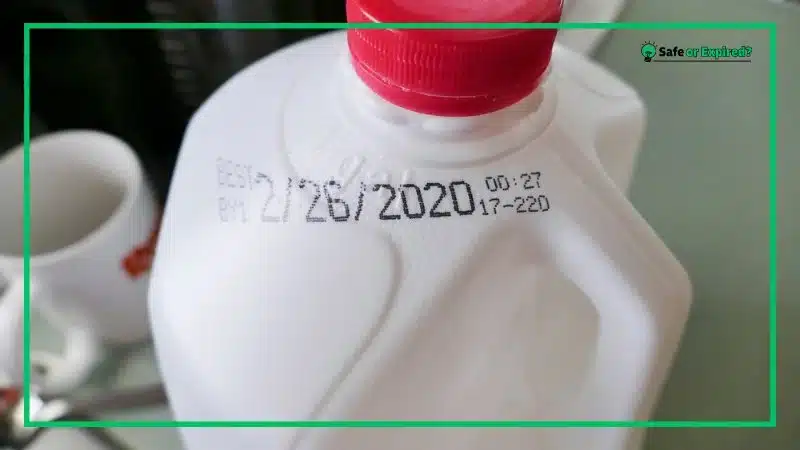
One of the first steps in identifying both quality and safe foods is to read labels and expiration dates carefully. Food labels have information about the nutritional content, ingredient list, and expiration or “best by” dates.
Quality foods often boast a higher nutritional value. They include vitamins, minerals, and whole ingredients. Safety is indicated by an expiration date that is in the future, ensuring the food is not past its prime consumption period.
Checking these dates is crucial for perishable items like dairy, meat, and some bakery goods to avoid foodborne illnesses.
Moreover, distinguishing between ‘expiration’ and ‘best by’ dates is essential for both quality and safety. For insights into how these dates should influence your food choices, read “Expiration vs Best By Dates: What’s the Difference?”
Understanding Food Certifications
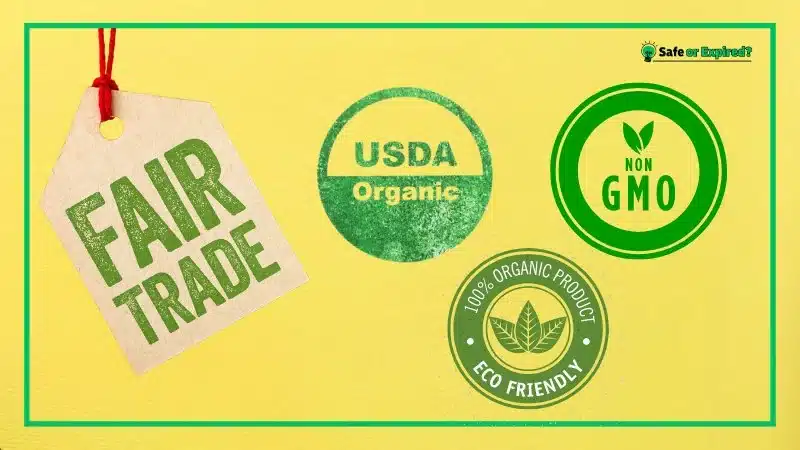
Various food certifications can also guide consumers in selecting quality and safe foods. Certifications such as USDA Organic, Non-GMO Project Verified, or Fair Trade indicate that the food meets specific standards regarding production and handling.
For example, organic certification ensures that produce is grown without synthetic pesticides or fertilizers.
Inspecting the Physical Quality
Physical inspection can reveal a lot about the quality and safety of food. According to MDPI, fresh produce should be free from excessive bruising, cuts, or signs of rotting. These things not only affect quality but can also be a safety concern due to the potential growth of harmful bacteria.
For packaged goods, ensure the packaging is intact, as damaged packaging can lead to contamination.
Researching Brands and Sources
Knowing where your food comes from can significantly impact its quality and safety, so choosing brands that prioritize top-notch ingredients and safe manufacturing methods really helps. Lots of folks prefer buying from local places. That way, they can find out straight from the source about how their food is grown or made.
Storing Foods Properly
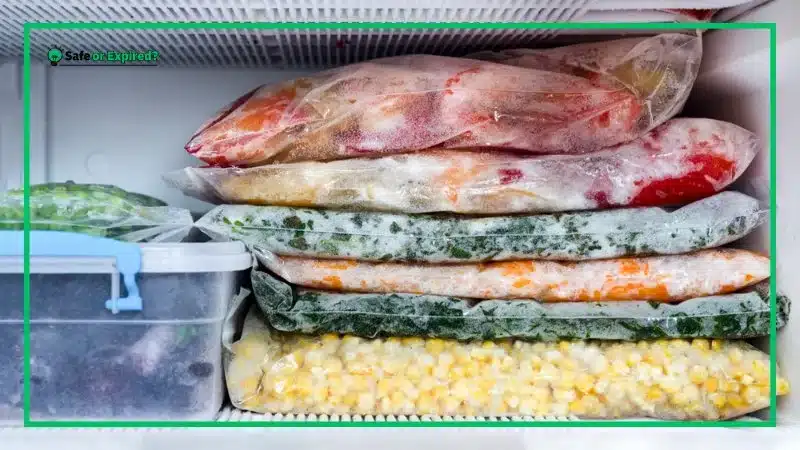
Once purchased, how food is stored at home can also affect its quality and safety. Ensure that perishable items are refrigerated or frozen promptly to maintain their safety. Proper storage can also preserve the quality of food, keeping it fresher for longer.
Misunderstandings about how to properly store and preserve food can affect both its quality and safety. To clear up any confusion and help ensure you’re following the best practices, delve into “10 Common Food Preservation Myths Exposed.“
Tips for Consumers to Maintain Food Safety at Home
To keep food safe at home, always wash your hands and kitchen surfaces before cooking. Store foods at the right temperatures—keep your fridge below 43°F and your freezer at 0°F. You should also cook food thoroughly. If confused, use a food thermometer to check. It’s also crucial to keep raw and cooked foods separate to avoid cross-contamination.
Clean: Wash Hands, Utensils, and Surfaces Often

Cleaning keeps the food safe. Remember these points:
- Regular handwashing with soap is essential.
- You must always clean utensils with hot, soapy water after preparing each food item.
- Always rinse raw fruits and veggies under running water without soap, and firm produce like melons or cucumbers should be scrubbed with a clean produce brush. However, meat, poultry, eggs, or seafood should not be washed to prevent spreading harmful germs.
Separate: Don’t Cross-Contaminate
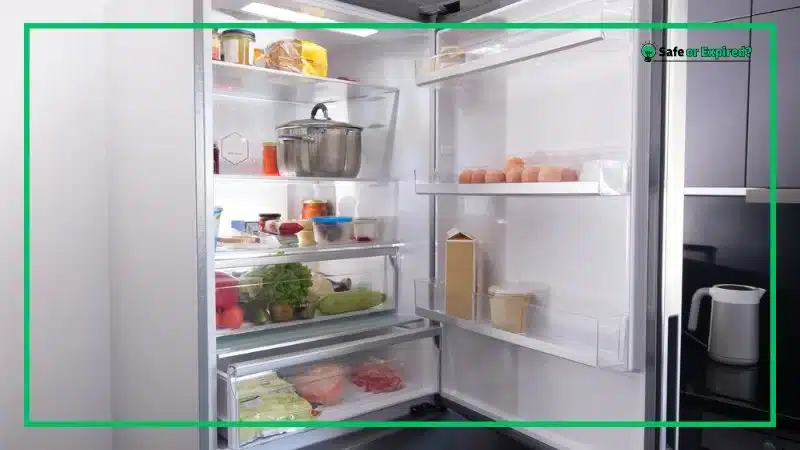
Remember these points to avoid cross-contamination:
- Use separate cutting boards and plates for fresh veggies and for raw meat (including seafood and eggs).
- Keep meat separate from other foods in your grocery cart, during checkout, and in your fridge.
Cook: Follow Safe Cooking Temperatures

You should cook foods to the right temperature to kill harmful germs.
- Microwave food thoroughly to 165°F, letting it sit for a few minutes after heating for even cooking.
- You should use a food thermometer to ensure you are cooking meats to a safe internal temperature: whole cuts of beef, pork, lamb, and veal to 145°F; fish with fins to 145°F or until opaque and separates easily; ground meats to 160°F; all poultry to 165°F; and leftovers and casseroles to 165°F.
Conclusion
Understanding food quality and safety is essential for anyone looking to enjoy their meals without compromise. Here are the key takeaways:
- Food Quality encompasses taste, nutrition, and appearance, aiming to satisfy consumer preferences.
- Food Safety focuses on preventing contamination and foodborne illnesses.
- Regulations play a crucial role in maintaining both quality and safety, with acts like the FSMA and guidelines like the FDA Food Code setting the benchmarks.
- Consumers can identify quality and safe foods through label reading, understanding certifications, and proper food handling and storage at home.
- At Home, maintaining food safety involves practices like cleaning, separating, cooking to the right temperatures, and chilling foods promptly.
Armed with this knowledge, you’re well on your way to making informed choices about the food you eat, ensuring every meal is a perfect blend of quality and safety.

